#fun fact friday
Text
Fun Fact: Hognose snakes are dramatic lil guys!
I am particularly fond of the snakes known as hognose snakes, and my reasons are both understandable and correct.
This is a hognose snake:
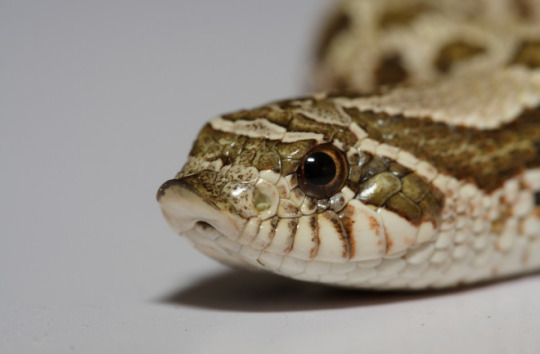
(They received their name by having the sweetest lil snoot to ever require a boop – image source)
They use these adorable snoots to burrow under sandy soil using a sort of nuzzle-y motion. They then use these burrows as a place to sleep at night, hibernate in the winter, and lay their eggs.

(you could say they’re into... the Underground Scene! ...ok yeah i’ll show myself out – image source)
Plus, they come in a variety of delightful colours!
We've got brown! Beige! Yellow! Black! Red! Orange! Tan! Kinda greenish! Orange again!

(pretty sneks! – Here’s all the image sources: 1, 2, 3, 4, 5, 6, 7, 8, 9)
And, to be clear, the snakes pictured above are wild snakes. No selective breeding by humans in these noodly bois! At least, not in these specific individuals. probably. I guess a few of them could be escapees...
But most importantly: These snakes know the true meaning of DRAMA
Hognose snakes are actors, first and foremost. When they feel threatened, the first thing they do is puff out their neck into a hood.
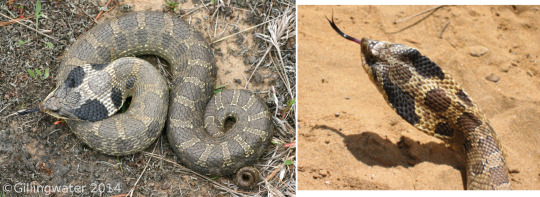
(like cobras, this hood is made by FLEXING THEIR NECK RIBS. which: gross – image source x)
This superficially makes them look like a cobra, but what they’re actually trying to do is make themselves seem bigger, and therefore scarier. Possibly those dark spots on their neck helps with that!
Any resemblance to real-life Eurasian cobras, real or fictional, is purely coincidental
Also, it makes its mouth do this:

(Snakes that SCREAAAAAAAM. – image source)
honestly, if I didn’t already know that hognose snakes were harmless, this would ABSOLUTELY make me leave it the hell alone
But if all of that^ is unsuccessful at scaring away the predator, the hognose snake pulls its signature move: playing dead
If you think that is a lame signature move, then you are wrong, because hognose snakes put EVERYTHING into their performance and I love them for it.
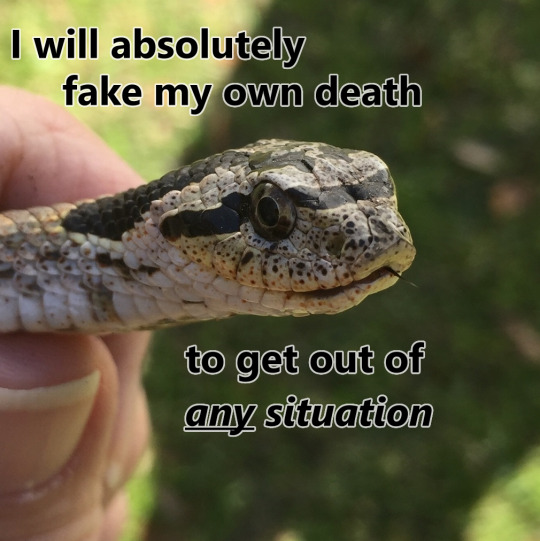
(they’re serious, they’ll do it! – image source)
((I’m actually going to stick the rest of this under a read-more, bc the pictures of the alive-and-physically-fine hognose snakes do kind of look like a legitimately-dead hognose snake, if you don’t know what to look for.
So, uh: cw for a snake being too good at pretending to be dead))
Behold: a series of completely healthy, unharmed snakes!!!

(to help with their self-esteem, we ask that you at least pretend to believe that they are dead – image sources 1, 2, 3, 4)
Honestly, the photos don’t do it justice. Here’s my favourite video of the whole wonderous performance:
undefined
youtube
But to review:
There's writhing! There's dramatic noises! There's flipping onto their back and opening their mouth wide and letting their tongue hang out! There's excreting a combination of intentionally smelly substances!!! Truly a master of the art of being left the hell alone (*^▽^*)

(yep. deeeeefinitely dead. not just faking it. nothing worth eating here! – image source)
Personally, my favourite part of this is how they insist on rolling onto their back, even when they are rolled back onto their stomach.
Seriously, if you try to roll them right-side-up, they will flip back over. It's as though they believe that a good, proper dead snek MUST be on its back, obviously.
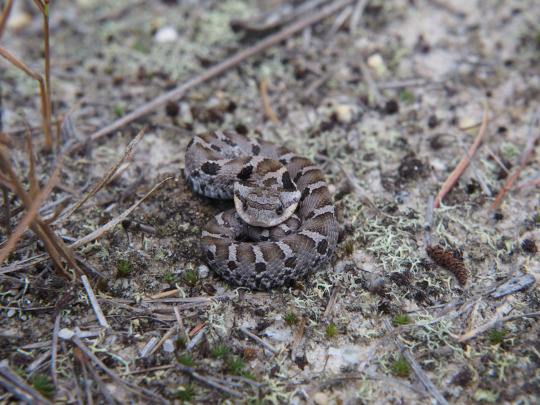
(truly fearsome – image source)
Sadly, the hognose snake may have made itself too scary, according to humans.
Out of fear, these snakes are commonly killed on sight 😔. I once heard someone proudly brag about how they’d killed a dozen cobras! In southern Ontario! Where cobras do not live! This is both extremely frustrating and deeply sad.

(safe enough to hold! although maybe don’t, just because this snake IS probably experiencing mortal fear, which is not a good feeling – image source © Dean Stavrides)
So just to highlight: hognose snakes are completely harmless. They’re just pretending to be fearsome!
(not that people should be killing venomous snakes either, imo. Let the danger noodles LIVE THEIR LIVES)
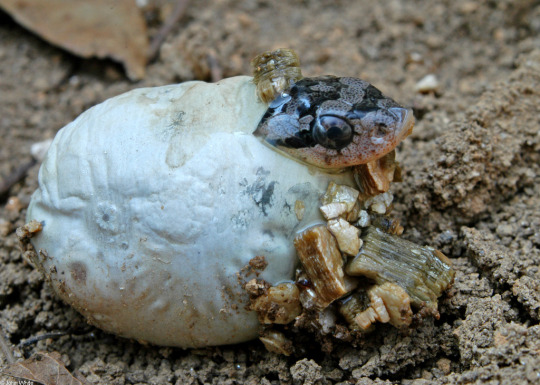
(i is baybee, pls do not hurt me – image source)
And now some bonus facts to help raise us out of that downer:
Hognose snakes are toad specialists! Their favourite food is toads, which is unusual, because toads are poisonous. Hognose snakes deal with this by force of will and also, at least two amino acid substitutions, maybe (Mohammadi et al. 2016). Possibly a few other things help with this, also (Feldman et al. 2016).
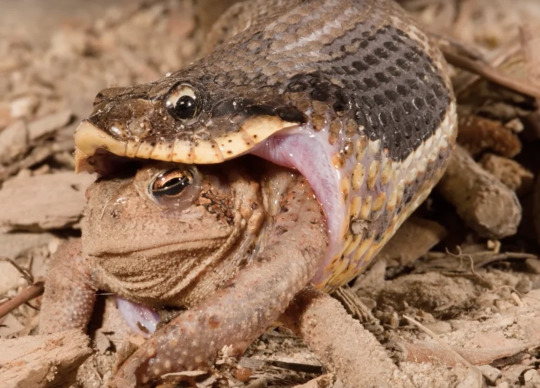
(is snek eat toad? or does toad wearing cape of snek? impossible to tell, really – image source)
Also, I have a confession: hognose snakes... are venomous. Technically.

(itty bitty little fangs at the veeeeery back of their mouth! – image source)
They are known as rear-fanged snakes, which means they have fangs aaaall the way at the back of their mouth. The venom they produce seems to be toad-specific, and is considered to be harmless to humans unless you happen to have an allergy but that's the exception rather than the rule

(the two hognose species. They are both baybee, but in different ways actually there might be more than two species but these are the two i’ve actually learned about so ALL WELL – image source)
Also, hognose snakes are big cowards NOT aggressive and I've never even heard of anyone getting bit by a one (outside of one feeding mishap, which we can all agree was an ACCIDENT).
The series of events that would need to occur for you to be envenomated are so unlikely and bizarre that I assume you would have to be TRYING to get bit.
This has been Fun Fact Friday, bringing you the forbidden noodly boys to try and keep them a little more safe!
.....................................................................
Sources, because I know me and SO DO YOU:
Averill-Murray, R. C. (2006). Natural history of the western hog-nosed snake (Heterodon nasicus) with notes on envenomation. Sonoran Herpetologist, 19(9), 98-101.
Buchanan, Scott W.; Timm, Brad C.; Cook, Robert P.; Couse, Richard; Hazard, Lisa C. (2017). Spatial ecology and habitat selection of eastern hognose snakes. The Journal of Wildlife Management, 81(3), 509–520. doi:10.1002/jwmg.21218
CHS: Canadian Herpetological Society https://canadianherpetology.ca/species/species_page.html?cname=Eastern%20Hog-nosed%20Snake
COSEWIC. 2021. COSEWIC assessment and status report on the Eastern Hog-nosed Snake Heterodon platirhinos in Canada. Committee on the Status of Endangered Wildlife in Canada. Ottawa. xi + 45 pp. https://www.canada.ca/en/environment-climate-change/services/species-risk-public-registry/cosewic-assessments-status-reports/eastern-hog-nosed-snake-2021.html
Cunnington, G. M., & Cebek, J. E. (2005). Mating and nesting behavior of the eastern hognose snake (Heterodon platirhinos) in the northern portion of its range. The American midland naturalist, 154(2), 474-478.
Feldman, C. R., Durso, A. M., Hanifin, C. T., Pfrender, M. E., Ducey, P. K., Stokes, A. N., ... & Brodie Jr, E. D. (2016). Is there more than one way to skin a newt? Convergent toxin resistance in snakes is not due to a common genetic mechanism. Heredity, 116(1), 84-91.
Jared, C., Luiz Mailho‐Fontana, P., & Maria Antoniazzi, M. (2021). Differences between poison and venom: An attempt at an integrative biological approach. Acta Zoologica, 102(4), 337-350.
Liu, C., Chen, Y., Zheng, Y., Bo, J., Yang, C., Xu, S., & Zhang, S. (2022). Wear Resistance Improvement of Keeled Structure and Overlapped Distribution of Snake Scales. Journal of Bionic Engineering, 1-11. Citing abstract.
Mohammadi, S., Gompert, Z., Gonzalez, J., Takeuchi, H., Mori, A., & Savitzky, A. H. (2016). Toxin-resistant isoforms of Na+/K+-ATPase in snakes do not closely track dietary specialization on toads. Proceedings of the Royal Society B: Biological Sciences, 283(1842), 20162111.
Nature Conservancy of Canada: https://www.natureconservancy.ca/en/what-we-do/resource-centre/featured-species/reptiles-and-amphibians/eastern-hog-nosed-snake.html
Plummer, M. V., & Mills, N. E. (1996). Observations on trailing and mating behaviors in hognose snakes (Heterodon platirhinos). Journal of Herpetology, 30(1), 80-82.
Rouse, Jeremy D.; Willson, Robert J.; Black, Ron; Brooks, Ronald J. (2011). Movement and Spatial Dispersion of Sistrurus catenatus and Heterodon platirhinos: Implications for Interactions with Roads. Copeia, 2011(3), 443–456. doi:10.1643/ce-09-036
Seburn, D. 2008. Recovery Strategy for the Eastern Hog-nosed Snake (Heterodon platirhinos) in Canada. Species at Risk Act Recovery Strategy Series. Parks Canada Agency, Ottawa. vi + 24pp.
Schwartz, V. & D. Golden (2002). Field Guide to Reptiles and Amphibians of New Jersey. New Jersey Division of Fish and Wildlife
VHS: Virginia herpetological society http://www.virginiaherpetologicalsociety.com/reptiles/snakes/eastern-hog-nosed-snake/eastern_hognose_snake.php#:~:text=Heterodon%20is%20derived%20from%20the%20Greek%20words%20heteros,meaning%20%22broad%20or%20flat%22%20and%20rhinos%20meaning%20%22snout%22
Young, R. A. (1992). Effects of Duvernoy's gland secretions from the eastern hognose snake, Heterodon platirhinos, on smooth muscle and neuromuscular junction. Toxicon, 30(7), 775-779. https://doi.org/10.1016/0041-0101(92)90013-U
Young, B. A., & Morain, M. (2003). Vertical burrowing in the Saharan sand vipers (Cerastes). Copeia, 2003(1), 131-137.
SARA: threatened https://www.canada.ca/en/environment-climate-change/services/species-risk-public-registry.html
#hognose snake#snakes#biology#fun facts#fun fact friday#science#sciblr#science side of tumblr#STEM#adhd in STEM#zoology#ecology#Herpetology#snake#i love these guys so so much#there's more but its late#also this is late#i wrote it last week but then stuff happened#well#i wrote most of it last week#some of it was written in 5 minutes of frenzied keyboard slamming#depression is STILL HERE#but im doing my best#also yes i know it's saturday but LET ME LIVE#Youtube
1K notes
·
View notes
Text
Fun Fact! Crosses!
I am not around, this is a queued Fun Fact! Don't send me requests! I won't see them!
Easter is coming up, so let’s talk about different kinds of crosses! You’ve probably seen most of these before, especially if you’re Catholic, but maybe you didn’t know the names!
Of course, most Christians are familiar with the Latin Cross:

That’s the classic one, of course.
The Greek Cross, with equal lengths on each bar:

Also a classic!
The Patriarchal Cross, which you see a lot in Orthodox churches:

The extra bar towards the top represents the ‘INRI’ sign Pilate posted on the Cross.
The Papal Cross:

I’m not actually sure what the deal with that one is.
The Chi Rho:

This takes the two Greek letters, ‘Chi’ and ‘Rho’ (first two letters of ‘Christos’ in Greek), and combines them.
The Jerusalem Cross, used in the Kingdom of Jerusalem in the Crusades:

I *believe* it represents how Jerusalem was believed to be the center of the world, and the crosses in the corners represent the four corners of the world? I think, anyhow.
The Tau Cross:

Also called Saint Anthony’s Cross, as it’s associated with Saint Anthony of Egypt. It’s also got Franciscan associations!
Cross of Saint James:

Big in Spain, obviously, where Saint James the Greater is quite popular. It’s the symbol of the Order of Santiago (Saint James).
Celtic Cross, which you see a lot in Irish stores as knick-knacks, though they’re also from Scotland and Wales:

Obviously modeled after those stone crosses you’ll see carved in the British Isles.
The Ankh, which Coptic Christians sort of grabbed from Egypt:

This was originally an Egyptian symbol for ‘life’, unrelated to the Cross as we know it in the original context.
The Maltese!

The symbol of the Knights of Saint John and the Order of Hospitallers! And obviously, the island of Malta.
And the Marian Crosses:


It combines the Latin Cross with the letter ‘M’, to emphasize how Mary was at the Crucifixion.
Hope this was something that you didn’t know!
110 notes
·
View notes
Text
Fun fact friday
Venus's years are shorter than its days, with a year being ~225 earth days long and a day on venus being ~243 earth days long
49 notes
·
View notes
Text
Credit: sportsgirlclub
Fun fact Friday!
(🎥: @carleecalf and @sportsgirlsclub on TT and IG)
( good news is that they probably do know who we are )
#sports for the girls#professional athletes#hockey#nhl#hockey players#I always wonder if they do check out social#tyler seguin#jack hughes#luke hughes#quinn hughes#trevor zegras#I wonder if they know about fan fics#I still have a Instagram post about Tyler Seguin and I think I @ him#just be delusional#its good to know#fun fact friday
22 notes
·
View notes
Text
Fun Fact Friday
Andromeda is on a collision course with the Milky Way.
It's also the largest galaxy in our local group!
26 notes
·
View notes
Text
Fun Fact!
Polaris, or more specifically Polaris Aa, is a gigantic star, nearly 40 times as large as the Sun and over a thousand times brighter. It is orbited by another star, Polaris Ab, a fairly normal, Sunlike star at roughly Uranus’s distance. Neither of these stars would be good conditions for planets.
But the system has a third star, Polaris b, that is just an ordinary, sunlike star and orbits the As at a 2400 AU distance. It’s entirely plausible there could be planets around it, even perhaps habitable ones.
Source: Quora
#celestial same picverse#celestial-same-picverse#celestial same picture#polaris posts#polaris#fun fact friday
23 notes
·
View notes
Text
FUN FACT
JUPITER IS THE OLDEST PLANET IN THE SOLAR SYSTEM
(Extra little fact: it was created from the leftover particles of the suns formation)
25 notes
·
View notes
Text
it's fun fact friday! does anyone want to share a fun fact?
116 notes
·
View notes
Text
Fun fact friday: stars can just be gone and we wouldn’t know because of how light works or something
16 notes
·
View notes
Text
It is OC Fun Fact Friday:
Reblog this post if you want people to come into your inbox and dump their fun/funny facts about their OCs. Do it. Inundate me with Knowledge.
#gw2#guild wars 2#Fun Fact Friday#gw2 oc#guild wars 2 oc#guildwars2#guildwars#guild wars#sylvari#norn#asura#charr#gw2 human
65 notes
·
View notes
Text
Fun Fact: Oilbirds are Basically BatBirds!
I want to talk about these amazing birds:
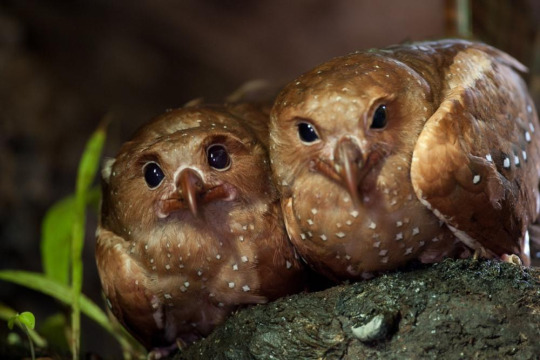
I love them. I mean, look at their big, shiny eyes! NO ONE can say that they aren’t cute as hell!
The other reason I love these animals is because they’re basically what happens when evolution tries to make a bat out of a bird.
These little guys are known as oilbirds (Steatornis caripensis), and are also called guácharo (and also several other things, because they are found in South America, plus Trinidad & Tobago, which all have INCREDIBLE language diversity).
Oilbirds are nocturnal, flying around the forests of South America at night looking for fruit to eat. They also live colonially in caves, which they navigate using echolocation.
So, to review:
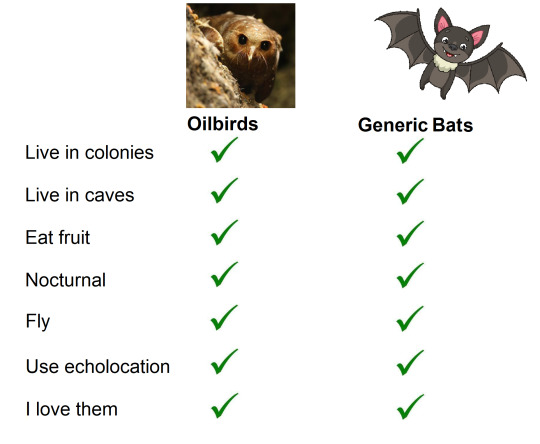
(I’m making my Generic Bats a very generic fruit bat, for the record).
Oilbirds are the only birds with this combination of traits, which I think is pretty cool of them! Why are they so much like bats? Basically, when different types of animals evolve under similar selective pressures, they often evolve the same features! This is called convergent evolution, and wow I talk about it a lot on this blog! It turns out that nocturnal animals that live in caves and eat fruit can sometimes benefit from traits like these!

(they’re, like... spooky-cute. Cute-spooky? Either way, I like them a lot)
So, if these birds are flying around at night, how do they stop themselves from flying into things while searching for that tasty, tasty fruit?
Well, in the forest, they mostly rely on their AMAZING night vision (which is another trait they share with bats, fyi). That is why they have such big, adorable eyes, which has a lot of light-sensing cells called rods. They actually hold a record for the density of the rods in their eyes: one million per square millimetre. That is the highest density of any known vertebrate. It’s about 6x denser than the rods found in human eyes!
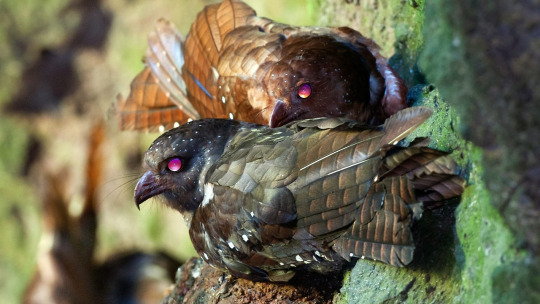
...still cute
Their amazing vision allows them to see very well in low light, which is how they navigate the South American jungles at night, searching for food under the moon and stars. That said, their vision just doesn’t cut it when it comes to flying in the caves they call home. Why? Well, caves are dark as hell, and even the best night-vision can’t do anything for you when there’s no light at all. Plus, flying into cave walls/ cliff faces hurts, so it’s good to be extra sure you’re not flying into solid rock!
So how do they find their way around these dark caves? Well, they use something very unusual for birds: echolocation!
Oilbirds are one of only a few species of birds that are known to use echolocation (the others are a few species of the closely-related swiflets (Collocaliini), but I HAVE DECIDED TODAY IS FOR THE OILBIRDS im sorry, swiflets, ilu2).
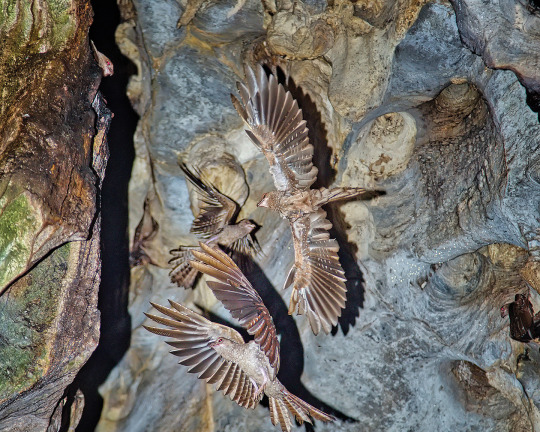
Look at them, not flying into rocks! I’m so proud (˃̣̣̥ ◡ ˂̣̣̥)
Also, a bonus fact, because idk where to fit this but I MUST mention it:
They have little whiskers around their beaks (which are technically called “rictal bristles”, but I’m going to call them “whiskers” because I like that word better). These whiskers are basically used to feel things that they have in and around their mouth, helping them find, manipulate, and eat their tasty fruit!

...moustache...
This has been Fun Fact Friday!
#science#birds#biology#sciblr#science side of tumblr#STEM#adhd in STEM#zoology#ecology#convergent evolution#fun fact friday#fun facts#oilbirds#I know i've been MIA for a while#my reason is that clinical depression CAME FOR ME#mental illness strikes again!#im not really better but im trying to get myself to experience joy by looking at cool birds#i also touched some trees and am in therapy and have new meds
7K notes
·
View notes
Note
The BIONICLE world has a canonical...hell?
Oh yeah, that's A Thing. I had been toying with that as a Fun Fact, but I kind of assumed we were all like

But I'm happy to hear I can put this back on the slate! So! Today You Learned about Karzanhi!
In BIONICLE, the main inhabitants of the world are these worker fellows called the Matoran, (the people the Toa protect) and they need to keep working for their world to keep functioning (this seems dystopian to me, but the story kind of glosses over that).
The Matoran have this legend that if you're a very good little worker you're sent to Artakha, a divine workshop island kingdom ruled by an entity also known as Artakha. They would work in this ultimate workshop with Artakha to create cooler gadgets and buildings than anywhere else in the world.
But if you're a bad little worker, you're sent to Artakha's brother, Karzanhi. There bad little workers go to his dark kingdom, and are never seen again...
Obviously we have Heaven and Hell parallels here. In the actual story, most of the characters don't believe this is real. In one book, the heroes come across an evil vine creature that's named Karzanhi after the legend.
But then a bit later we find out that Karzanhi is totally real...

Except... he's kind of a doof. See, bad workers weren't sent to his kingdom as punishment, they were sent because Karzanhi's job is to fix them (these are bionic beings, remember?). The idea was Matoran who were bad workers because they needed some kind of repairs were sent to his kingdom for him to repair and send back. But Karzanhi was garbage at his job, so instead of sending them back after "repairing" them, he just sent them away, or kept them in his own kingdom. The reason Matoran never came back was because he was hiding his own shoddy work.
In fact, he also doesn't realize anything exists outside of his own work. When the heroes pass through his kingdom trying to get to the Plot, he doesn't believe that they're saving the world because as far as he knows, the world is just peachy! When he finds out from them how bad things are, he decides to take a hand in world events himself. And predictably, screws things up even worse.
[He also eventually gets a set that looks nothing like his illustration, because mutation shenanigans, but whatever.]
So yeah! BIONICLE Hell! If you ever see me use 'WTK' that stands for "What the Karzanhi?" We in the BIONICLE fandom used it back on BZPower.
246 notes
·
View notes
Text
Fun fact friday
Venus may have been a habitable ocean world billions of years ago
Follow for more fun facts on friday
9 notes
·
View notes
Text
Fun Fact Friday!
Titan is the second largest moon in the solar system!
9 notes
·
View notes
Text
Fun fact friday!
Eris has a moon named Dysnomia!
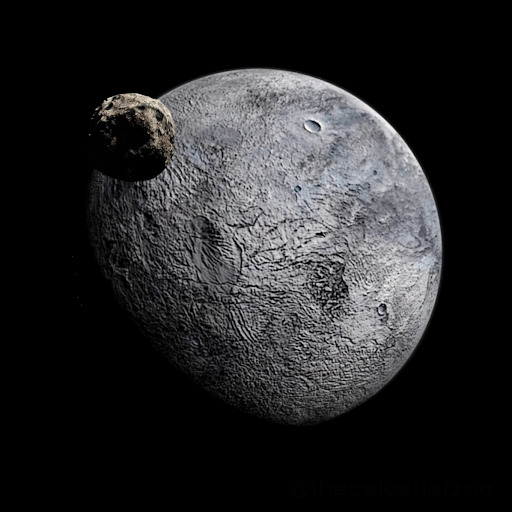
9 notes
·
View notes
Text
Fun Fact Friday:
Polaris is actually a triple star system!

#celestial same picverse#celestial-same-picverse#celestial same picture#polaris posts#polaris#fun fact friday#fun-fact-friday
13 notes
·
View notes